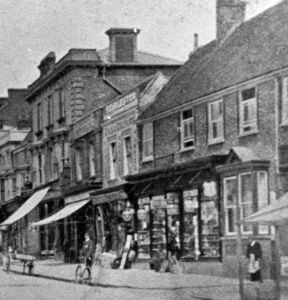Restoration Work Starts On 21-23 High Street South
By Historic England 17 November 2023
- Repair and restoration work is starting on 21-23 High Street South (formerly Moore’s) to improve the historic shop front of the buildings
- The repair project is part of the Dunstable High Street Heritage Action Zone, run by Dunstable Town Council and supported by Historic England
- The buildings currently have post-war shop fronts, but date to the 18th and mid-to-late 19th century
- Number 21 High Street South was the home of James Tibbett, creator of the town’s first newspaper
Work is about to start to reinstate the historic shopfronts of the Capital Developments Group building at 21-23 High Street South (formerly Moore’s) as part of the Dunstable High Street Heritage Action Zone, run by Dunstable Town Council and supported by Historic England.
Capital Developments Group have consented to the works being carried out by contractors DJ Russell and overseen by Conception Architects Studio, which will include the restoration of historic shop fronts, the repair and reinstatement of first floor windows on both properties, and the repair of the historic roof.
The works will open up the closed commercial space on the ground floor and provide residential accommodation on both the ground and first floors within the proposed development plans.
Comments
Dunstable Town Mayor Cllr Liz Jones said: “I am delighted to witness the careful and dedicated restoration of the shop front at 21-23 High Street South. The historic Moore’s building is a monumental asset to Dunstable’s High Street. The works to preserve the character and heritage of the building will revitalise its purpose and secure a future where the building remains integral to the Dunstable Conservation Area for generations to come.’’
Tony Calladine, East of England Regional Director, Historic England, said: “It’s great to see the repair and restoration of 21-23 High Street South get underway. These buildings have fascinating local history and I look forward to seeing their character revealed and the properties revitalised for future use.”
Dr Valeria Passetti FRIBA SCA IHBC, Managing Director, Conception Architects Studio, said: “The proposal seeks to repair and to reinstate the historic architectural features that will return those buildings back to the significance they historically had within the Dunstable Conservation Area. The work will also seek to futureproof the buildings and ensure they will continue to be used for many years to come.”
Jordon Foux MRICS, Director, Capital Developments Group, said: “We are delighted to partner up with Dunstable Town Council and Historic England on the frontage element of our commercial and residential development scheme, which will greatly enhance and improve the High Street helping to reinstate the important historical character of the area.”
The history of 21-23 High Street South
Number 21 High Street South first appears in local records on 31 December 1793, occupied by tailor Richard Underwood. The Underwood family continued to live in the property until 1851, when James Tibbett, a printer and stationer, rented the property. James started the town’s first newspaper, The Dunstable Chronicle, in 1855. The Tibbett family lived at number 21 until some point between 1891 and 1897, expanding their business into 23a sometime between 1890 and 1891.
By 1898, number 21 was occupied by Arthur Spendlove, a draper and dressmaker, and by 1903 it was Lester S.C. & R. builders’ ironmongers. The street-facing block was remodelled in the mid-to-late 19th century, with larger windowpanes a prominent feature.
Number 21 was briefly back in the Tibbett family in 1911, under Gordon Frank Tibbett, a watchmaker and jeweller, and his wife Ethel, a milliner. In 1923, Charles Moore, a draper, was the owner, and his family continued to run the shop until its closure in 2008.
The present minimalist frontage, spanning two storeys, was created between 1956 and 1964, for Moore’s store.
A block plan of number 23 is visible on the tithe map of 1840, and the shape of the building is very similar today.
Number 23 was originally divided into two properties, numbers 23a and 23b, which wrapped around each other to form a single block. In 1841, 23a was occupied by six women, all aged between 15 and 25. Three were dressmakers, two were milliners and one was a servant.
In 1861, number 23a is recorded as a ‘Butin Wool & Fancy Shop’ run by cousins Mary Windmill and Elizabeth Foster, while their extended family made bonnets. By 1876, it was a glass and china shop.
Number 23b is first identified in a trade directory from 1839, when William Batchelor, a surgeon, lived in the property. At the time of the 1851 census, number 23b was occupied by physician and surgeon William Forbes Laurie, in a household of 12 people. Following Laurie’s death in 1880, his widow continued to live at the property until some point between 1881 and 1891. Another doctor, Arthur B. Druitt, moved in but his residency was short-lived.
At some point between 1891 and 1897, the two properties were brought under the ownership of the Tibbett family.
By 1924, the Tibbetts had moved out of 23 High Street South and Boots the Chemist remodelled the building for the opening of a store in May of that year.
The present shopfront is thought to date from around 1963. Boots moved out of 23 High Street South in 1966 and soon after, Moore’s, based at number 21, expanded into this adjacent building. Moore’s closed down in 2008 and both buildings have been vacant since then.






